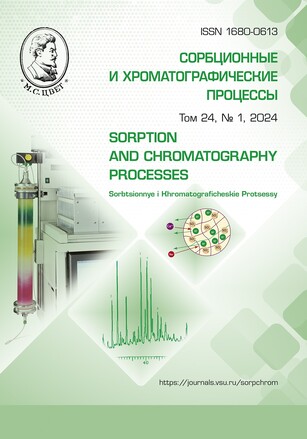Interaction of melanoidins, proline, and valine with sorbents of various nature
Abstract
The isolation of pure amino acids from industrial solutions is one of the important tasks of production. Solutions of amino acids obtained as a result of chemical or microbiological treatment contain a number of impurities, mostly organic ones. The microbiological synthesis of proline is accompanied by the presence of valine, leucine, alanine, and coloured high-molecular components in the culture liquid that belong to the melanoidin group. Melanoidins of proline acid production are high-molecular compounds containing amino acid fragments, heterocyclic structures, and amide bonds. Melanoidins in solutions can exist in cationic, bipolar, and anionic forms. They have different molecular weights, molecular sizes, and isoelectric states.
Various ion exchange methods can be used to isolate the target amino acid. It should be noted that the interaction of amino acids with ion-exchange materials is a complex process depending on the electrolytic properties of the sorbate and sorbent and accompanied by multiple side effects. It is necessary to know the specific features of interaction in the “amino acid - sorbent” system and the factors that affect the transport of sorbate ions in the sorbent phase when choosing an isolation method for the target product. The goal of this work was to determine the impact of pH on the sorption process of proline and valine by high-basic ion exchangers, to identify the features of their interactions, and to use the obtained results to optimise the conditions for the separation of amino acids.
We studied the process of interaction of bipolar ions and anions of proline (Pro±, Pro-) and valine (Val±, Val-) with anionites AV-17-8 and AV-17-2P. It was established that the mechanism of amino acid ion exchange in granular sorbents depended on the рН value in the “anionite - external solution” system. Based on the studied interactions, we suggested the methods of the anion-exchange separation of proline and valine. The selected conditions of separation of proline and valine were on anionite AV-17-2P in ОН-form (рН of the initial solution was 6.6-6.7; the solution flow rate was 2 cm3/min). The results of separation of proline and valine indicated that even in a one-step sorption process, five to seven fractions with proline contained no valine ions, while the concentration of proline was 2.0-2.7 times higher as compared to the original solution.
Downloads
References
Murav'ev D.N., Obrezkov O. N. Issledovanie sverhjekvivalentnoj sorbcii cvitterlitov. Zhurn. fiz. himii. 1986; 60 (2): 396-401. (In Russ.).
Davankov V. A, Navratil Dzh., Uolton H, Ligandoobmennaja hromatografija. M., Mir, 1990, 294 р. (In Russ.).
Selemenev V.F. Mezhmolekuljarnye vzaimodejstvija i obrazovanie peresyshhennyh rastvorov aminokislot v faze vysokoosnovnogo anionita / V.F. Selemenev, O.B. Rudakov, D.L. Kotova, T.V. Eliseeva, I.V. Voronyuk, S.I. Karpov, N.A. Belanova et al. V kn. «Nasledie M.S. Cveta v trudah voronezhskih himikov». V.1. Voronezh, Nauchnaja kniga, 2021: 89-131. (In Russ.).
Lindenmeier M., Faist V., Hormann T. Structural and functional characterization of prolyn-lysine, a novel protein modification in bread crust melanoidins showing in vitro antioxidative and phase I/II enzyme modulating activity. J. Agricultural and food chemistry. 2002; 50: 6697-7006.
Sapronov A.R., Sapronova L.A., Ermolaev S.V. Tehnologija saharnogo proizvodstva. Sankt-Peterburg, ID «Professija», 2015, 296 р. (In Russ.).
Ponomareva A.M. Reakcija melanoidinoobrazovanija i ee rol' v processe prigotovlenija hleba. Prikladnaja biohimija i mikrobiologija. 1965; 1 (5): 566-584. (In Russ.).
Selemenev V.F. Melanoidiny. Voronezh: Izd. VGU, 2004, 195 р. (In Russ.).
Selemenev V.F., Rudakov O.B., Slavinskaja G.V., Drozdova N.V. Pigmenty pishhevyh proizvodstv (melanoidiny). M., DeLi print, 2008. 246 р. (In Russ.).
Tarasova I.A. Issledovanija saharosoderzhashhih krasjashhih rastvorov metodom differencial'no skanirujushhej kalorimetrii. Sahar. 2017; 3: 48-49. (In Russ.).
Cjurupa M.P. Pogloshhenie okrashennyh veshhestv iz fermentacionnyh rastvorov lizina «sverhsshitym» polistirol'nym sorbentom. Prikladn. biohimija i mikrobiologija. 1985; 21 (1): 72-77.
Selemenev V.F. Obmennye processy i mezhmolekuljarnye vzaimodejstvija v sisteme anionit-voda-aminokislota: Diss...d-ra him. nauk. Voronezh, 1993. 596 р.
Pimentel Dzh., Mak-Klellan O. Vodorodnaja svjaz'. M., Mir, 1964, 462 р.
Dehant I. Infrakrasnaja snektroskonija polimerov. M., Himija, 1976, 471 р.
Zagorodni A.A., Kotova D. L, Selemener V.F. Infrared spectroscopy of ion exchange resins: chemical deterioration of the resins. Reactive and Functional Polymers. 2002; 53: 157-171.
Borrelli R.C., Viscontu A., Mennella C., et al. Chemical characterization and antioxidant properties of coffee melanoidins. J. Agric.Food Chem. 2002; 50 (22): 6527-6533.
Martins S.J.F.S., Van Boekel M.A.H.S. Melanoidins extinction coefficient on the glucose/glycine Maillard reaction. Food Chemistry. 2003; 83 (1): 135-142.
Patil P.U., Kapadnis B.H., Dhamankar V.S. Decolorisation of synthetic melanoidin and biogas effluent by immobilised fungal isolate of Aspergillus niger UM2. Internat. sugar Journal. 2003; 105: 1249.
Chikin G.A., Mjagkoj O. N. Ionoobmennye metody ochistki veshhestv. Voronezh, Izd. VGU, 1984, 372 р. (In Russ.).
Hajs N. M., Macek K. M. Hromatografija na bumage. Moskva, IL, 1962, 831 р.
Selemenev V.F. Bezreagentnye ionoobmennye metody vydelenija fiziologicheski aktivnyh veshhestv. Vedushhie nauchno-pedagogicheskie kollektivy. Voronezh, Voronezh. un-t, 2003, 588 р. (In Russ.).
Obretenov C., Demyttenaere J., Tehrani K.A., et al. Flavor release in the presence of melanoidins prepared from L-(+)-ascorbic acid and amino acids. J. Agricultural Food Chemistry, 2002; 50 (15): 4244-4250.







